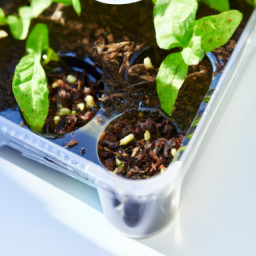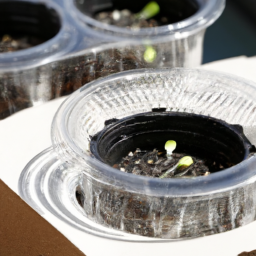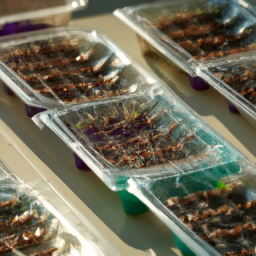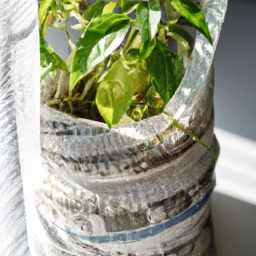
Are you looking to give your seedlings the best start possible? If so, investing in a grow light for seedlings may be just what you need. Providing the right amount and type of light is crucial for the healthy growth of seedlings, especially when natural sunlight is limited. In this blog post, we will explore the benefits of using grow lights for seedlings and provide some tips on how to choose the best one for your needs. Let’s dive in and learn more about how grow lights can help your seedlings thrive!
Benefits of Using a Grow Light for Seedlings
Introduction
When it comes to growing healthy and vibrant seedlings, providing the right amount of light is crucial. While natural sunlight is always the best option, sometimes it may not be enough, especially during the winter months or if you live in a location with limited sunlight. This is where grow lights come in handy. In this article, we will discuss the benefits of using a grow light for seedlings and how it can help you achieve successful seedling growth.
Increased Growth and Development
One of the main benefits of using a grow light for seedlings is that it can significantly increase the growth and development of your plants. Grow lights provide a consistent and uniform light source that mimics natural sunlight, promoting photosynthesis and allowing seedlings to thrive. With the right spectrum of light, seedlings can grow faster, stronger, and healthier, leading to better overall plant growth.
In addition to promoting growth, grow lights can also help seedlings develop strong roots and stems. By providing the right amount of light intensity and duration, grow lights encourage robust root growth and sturdy stems, which are essential for healthy plant development. This can result in seedlings that are better equipped to withstand transplanting and environmental stressors, ultimately leading to more successful plant growth.
Furthermore, grow lights can help prevent seedlings from becoming leggy or spindly. Leggy seedlings occur when plants stretch out in search of light, resulting in weak and elongated stems. By providing a consistent light source close to the seedlings, grow lights can help prevent this issue and promote compact and sturdy plant growth. This can ultimately lead to healthier and more resilient plants that are better prepared for transplanting and outdoor conditions.
Overall, the increased growth and development that result from using a grow light for seedlings can lead to stronger, healthier, and more successful plants. By providing the right amount of light at the right spectrum, grow lights can help your seedlings thrive and reach their full potential.
Extended Growing Season
Another significant benefit of using a grow light for seedlings is that it can extend the growing season for your plants. Grow lights allow you to start seeds indoors earlier in the year, giving your plants a head start and allowing you to enjoy a longer growing season. This can be particularly beneficial for gardeners in colder climates or areas with short growing seasons, as it provides more time for plants to mature and produce a bountiful harvest.
In addition to extending the growing season, grow lights also allow you to grow a wider variety of plants indoors year-round. Whether you want to start seeds early, grow herbs and vegetables indoors, or cultivate tropical plants that require more light, grow lights provide the flexibility to grow a diverse range of plants regardless of the outdoor conditions. This can be especially useful for gardeners who want to experiment with different plant varieties or grow plants that are not well-suited to their climate.
Furthermore, using a grow light for seedlings can help you maintain a consistent and controlled environment for your plants. By providing a stable light source with the right spectrum and intensity, grow lights allow you to create optimal growing conditions for your seedlings, regardless of the weather or season. This can help you achieve more predictable and successful plant growth, leading to healthier and more productive plants in the long run.
Overall, the extended growing season and increased flexibility that result from using a grow light for seedlings can provide numerous benefits for gardeners. Whether you want to start seeds early, grow a wider variety of plants indoors, or maintain a controlled growing environment, grow lights offer a versatile and effective solution for successful plant growth.

How to Choose the Right Grow Light for Your Seedlings
Understanding the Different Types of Grow Lights
When it comes to choosing the right grow light for your seedlings, it’s important to understand the different types of grow lights available on the market. The most common types of grow lights include fluorescent, LED, and high-intensity discharge (HID) lights.
Fluorescent lights are a popular choice for seedlings because they are affordable and easy to use. They come in two main types: T5 and T8. T5 lights are more energy-efficient and provide a higher light output, making them ideal for seedlings. T8 lights are less efficient but still work well for seedlings.
LED lights are becoming increasingly popular for growing seedlings because they are energy-efficient and long-lasting. They also produce less heat, which can be beneficial for seedlings that are sensitive to temperature changes. LED lights come in various spectrums, so it’s important to choose one that is suitable for seedlings.
HID lights are the most powerful grow lights and are commonly used for larger plants. They produce a lot of heat and require a ballast to operate. While HID lights can work well for seedlings, they may be too intense for some plants.
Factors to Consider When Choosing a Grow Light
When choosing a grow light for your seedlings, there are several factors to consider to ensure you select the right one for your plants. One of the most important factors to consider is the light spectrum. Different plants have different light requirements, so it’s essential to choose a grow light that provides the right spectrum for your seedlings.
Another factor to consider is the wattage of the grow light. The wattage of the light will determine how much light output it produces. Seedlings typically require lower wattage lights, so it’s important to choose a light that is suitable for the size of your seedlings.
The light intensity is also an essential factor to consider when choosing a grow light for your seedlings. Seedlings require a certain level of light intensity to grow properly, so it’s important to choose a light that provides the right amount of light for your plants.
Tips for Choosing the Right Grow Light
When choosing a grow light for your seedlings, it’s essential to consider the size of your growing area. Make sure to measure the size of your space to determine how many lights you will need to provide adequate coverage for your seedlings.
It’s also important to consider the duration of light exposure for your seedlings. Most seedlings require around 12-16 hours of light per day, so make sure to choose a grow light that can provide the necessary light exposure for your plants.
Lastly, consider the cost and energy efficiency of the grow light. While it may be tempting to choose a cheaper option, investing in a high-quality, energy-efficient grow light will benefit your seedlings in the long run.
By considering these factors and tips, you can choose the right grow light for your seedlings and ensure they receive the proper light exposure to grow healthy and strong.

Best Practices for Using Grow Lights to Promote Seedling Growth
As an expert in the field of grow lights for seedlings, I have seen firsthand the positive impact that proper lighting can have on the growth and development of young plants. In this guide, I will outline the best practices for using grow lights to promote seedling growth, from choosing the right type of light to setting up a proper lighting schedule.
Choosing the Right Type of Grow Light
When it comes to choosing a grow light for your seedlings, there are several options to consider. The most common types of grow lights used for seedlings are fluorescent, LED, and HID lights. Each type of light has its own advantages and disadvantages, so it’s important to choose the one that best suits your needs.
Fluorescent lights are a popular choice for seedlings because they are affordable and provide a good amount of light for young plants. However, they can be less energy efficient than other types of grow lights and may need to be replaced more often.
LED lights are another popular option for seedlings because they are energy efficient and can provide a full spectrum of light that is ideal for plant growth. They are more expensive upfront, but they tend to last longer than fluorescent lights, making them a cost-effective option in the long run.
HID lights are the most powerful type of grow light available, making them ideal for large-scale growing operations. However, they can be expensive to purchase and operate, so they may not be the best choice for small-scale growers or hobbyists.
Setting Up Your Grow Light System
Once you have chosen the right type of grow light for your seedlings, it’s important to set up your lighting system properly to ensure optimal growth and development. Start by positioning your grow lights so that they are close to the tops of your seedlings, but not so close that they risk burning the plants.
It’s also important to consider the duration of light exposure for your seedlings. Most seedlings require around 14-16 hours of light per day to promote healthy growth. You can use a timer to automate your lighting schedule and ensure that your seedlings are getting the right amount of light each day.
In addition to light intensity and duration, it’s important to consider the color spectrum of your grow lights. Different colors of light can affect plant growth in different ways, so it’s important to choose a light that provides a full spectrum of colors to promote overall plant health.
Troubleshooting Common Grow Light Issues
Even with the best practices in place, you may encounter some common issues when using grow lights for seedlings. One common issue is light burn, which occurs when seedlings are exposed to too much light or light that is too intense. To prevent light burn, make sure to adjust the height and intensity of your grow lights as needed.
Another common issue is light deficiency, which can occur when seedlings are not getting enough light to promote healthy growth. If you notice that your seedlings are becoming leggy or pale, consider increasing the duration or intensity of your lighting schedule to provide the light they need.
By following these best practices for using grow lights to promote seedling growth, you can help ensure that your young plants thrive and develop into strong, healthy specimens. With the right type of light, proper setup, and attention to detail, you can set your seedlings up for success and enjoy a bountiful harvest in the months to come.
Here’s the Summary Snapshot
If you’re an aspiring gardener or plant enthusiast, you may have heard about the benefits of using grow lights for seedlings. These specialized lights provide the necessary light spectrum for young plants to thrive and grow strong. Whether you’re starting your garden indoors or need to supplement natural sunlight, grow lights can be a game-changer for your seedlings.
Grow lights come in various types, including fluorescent, LED, and high-intensity discharge (HID) lights. Each type has its own advantages and considerations, such as energy efficiency, light spectrum, and cost. When choosing a grow light for your seedlings, it’s important to consider the specific needs of your plants and the space you have available. With the right grow light setup, you can ensure that your seedlings receive the light they need to develop into healthy, vibrant plants.
Top FAQs:
Q1. What is a grow light and why do seedlings need it?
A1. A grow light is an artificial light source designed to stimulate plant growth by emitting an electromagnetic spectrum suitable for photosynthesis. Seedlings need grow lights because they require a certain amount of light to thrive, especially when they are being grown indoors or in low-light conditions.
Q2. What type of grow light is best for seedlings?
A2. The best type of grow light for seedlings is typically a full spectrum LED grow light. LED grow lights are energy-efficient, produce little heat, and provide the right balance of light for seedlings to grow strong and healthy.
Q3. How far should the grow light be from seedlings?
A3. The distance between the grow light and seedlings will depend on the type of light and the specific needs of the plants. As a general rule of thumb, LED grow lights should be positioned around 12-18 inches away from seedlings to prevent burning and ensure optimal light absorption.
Q4. How long should seedlings be exposed to grow lights each day?
A4. Seedlings typically need around 14-16 hours of light per day to mimic the natural daylight cycle. It’s important to provide a consistent light schedule to promote healthy growth and development.
Q5. Can I use a regular light bulb as a grow light for seedlings?
A5. While regular light bulbs may provide some light for seedlings, they are not designed to emit the full spectrum of light needed for optimal plant growth. It’s best to invest in a dedicated grow light to ensure that your seedlings receive the right amount and type of light for healthy development.
Dr. Olivia Green is a botanist with over two decades of experience in indoor plant cultivation. She holds a Ph.D. in Plant Biology and has dedicated her career to researching plant behavior in controlled environments. Dr. Green is passionate about helping plant enthusiasts master the art of indoor gardening through her extensive knowledge and practical insights.


